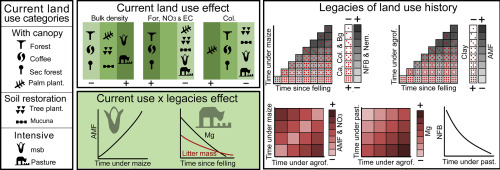当前位置:
X-MOL 学术
›
Appl. Soil Ecol.
›
论文详情
Our official English website, www.x-mol.net, welcomes your
feedback! (Note: you will need to create a separate account there.)
Disentangling the effects of legacies from those of current land use on soil properties in Los Tuxtlas Biosphere Reserve, Mexico
Applied Soil Ecology ( IF 4.8 ) Pub Date : 2020-09-01 , DOI: 10.1016/j.apsoil.2020.103578 Simoneta Negrete-Yankelevich , Carlos Andrés Cultid-Medina , Tajín Fuentes-Pangtay , Javier Álvarez-Sánchez , Silke Cram , José Antonio García-Pérez , Carlos Fragoso , Esperanza Martinez-Romero , Patricia Rojas , Lucía Varela-Fregoso , Julián Bueno-Villegas , Isabelle Barois
Applied Soil Ecology ( IF 4.8 ) Pub Date : 2020-09-01 , DOI: 10.1016/j.apsoil.2020.103578 Simoneta Negrete-Yankelevich , Carlos Andrés Cultid-Medina , Tajín Fuentes-Pangtay , Javier Álvarez-Sánchez , Silke Cram , José Antonio García-Pérez , Carlos Fragoso , Esperanza Martinez-Romero , Patricia Rojas , Lucía Varela-Fregoso , Julián Bueno-Villegas , Isabelle Barois

|
Abstract Soil properties are the product of current land use as well as legacies of historic use. Disentangling these effects is particularly challenging in tropical landscapes where plot-level land use history consists of varied sequences of uses punctuated by periods of abandonment. Here, we studied the soils of 63 plots in three sites of the Los Tuxtlas Biosphere Reserve, Mexico, and used detailed landowner accounts of land use history to model the effects of land use and its legacies. Electrical conductivity, N-NO3− and ant species richness were higher in current land uses featuring developed canopies (forests, secondary growth and palm and coffee plantations) compared to intensive land uses (livestock pastures and maize-slash and burn). Land uses aimed at soil restoration (maize-mucuna and tree plantations on degraded soils) improved soil bulk density only with respect to intensive land uses. The most frequent effects of historical land use variables (time since forest felling and cumulative times under each land use type) on soil properties occurred in interaction with each other and independently of the current land use. Beta glucosidase activity, pH and nematode richness were explained exclusively by historical use. In general, the duration of use dictated soil deterioration; however, the accumulation of time under intensive land uses had stronger legacies, in terms of soil physical and chemical properties, compared to that under agroforestry (coffee and palm cultivation). The richness of four taxa was sensitive to the land use history variables. Surprisingly, Nematoda and plant symbionts (nitrogen fixing bacteria and arbuscular mycorrhizal fungi) richness, but not that of Coleoptera, increased with accumulated time (20–40 yr) under maize cultivation. We suggest that the long history of traditional maize cultivation in polycultures has permitted the development of a rich soil biota.
中文翻译:

将遗产与当前土地利用对墨西哥洛斯图斯特拉斯生物圈保护区土壤特性的影响分开
摘要 土壤特性是当前土地利用和历史利用遗产的产物。在热带景观中,解开这些影响尤其具有挑战性,在那里,地块级土地利用历史由各种不同的使用序列组成,并被废弃时期打断。在这里,我们研究了墨西哥洛斯图斯特拉斯生物圈保护区三个地点的 63 个地块的土壤,并使用土地使用历史的详细土地所有者帐户来模拟土地使用及其遗产的影响。与集约化的土地利用(畜牧牧场和玉米刀耕火种)相比,当前具有发达树冠的土地利用(森林、二次生长以及棕榈和咖啡种植园)的电导率、N-NO3− 和蚂蚁物种丰富度更高。旨在恢复土壤的土地利用(退化土壤上的玉米-黧豆和树木种植园)仅在集约化土地利用方面提高了土壤容重。历史土地利用变量(森林砍伐后的时间和每种土地利用类型下的累积时间)对土壤特性的最常见影响相互影响,且与当前土地利用无关。β 葡萄糖苷酶活性、pH 值和线虫丰富度完全由历史使用来解释。一般来说,使用时间长短决定了土壤的恶化;然而,与农林业(咖啡和棕榈种植)相比,集约化土地利用下的时间积累在土壤物理和化学特性方面具有更强的影响力。四个分类群的丰富度对土地利用历史变量很敏感。出奇,线虫和植物共生体(固氮细菌和丛枝菌根真菌)的丰富度,而不是鞘翅目的丰富度,随着玉米种植的累积时间(20-40 年)而增加。我们认为,混合栽培中传统玉米种植的悠久历史已经允许发展丰富的土壤生物群。
更新日期:2020-09-01
中文翻译:

将遗产与当前土地利用对墨西哥洛斯图斯特拉斯生物圈保护区土壤特性的影响分开
摘要 土壤特性是当前土地利用和历史利用遗产的产物。在热带景观中,解开这些影响尤其具有挑战性,在那里,地块级土地利用历史由各种不同的使用序列组成,并被废弃时期打断。在这里,我们研究了墨西哥洛斯图斯特拉斯生物圈保护区三个地点的 63 个地块的土壤,并使用土地使用历史的详细土地所有者帐户来模拟土地使用及其遗产的影响。与集约化的土地利用(畜牧牧场和玉米刀耕火种)相比,当前具有发达树冠的土地利用(森林、二次生长以及棕榈和咖啡种植园)的电导率、N-NO3− 和蚂蚁物种丰富度更高。旨在恢复土壤的土地利用(退化土壤上的玉米-黧豆和树木种植园)仅在集约化土地利用方面提高了土壤容重。历史土地利用变量(森林砍伐后的时间和每种土地利用类型下的累积时间)对土壤特性的最常见影响相互影响,且与当前土地利用无关。β 葡萄糖苷酶活性、pH 值和线虫丰富度完全由历史使用来解释。一般来说,使用时间长短决定了土壤的恶化;然而,与农林业(咖啡和棕榈种植)相比,集约化土地利用下的时间积累在土壤物理和化学特性方面具有更强的影响力。四个分类群的丰富度对土地利用历史变量很敏感。出奇,线虫和植物共生体(固氮细菌和丛枝菌根真菌)的丰富度,而不是鞘翅目的丰富度,随着玉米种植的累积时间(20-40 年)而增加。我们认为,混合栽培中传统玉米种植的悠久历史已经允许发展丰富的土壤生物群。











































 京公网安备 11010802027423号
京公网安备 11010802027423号